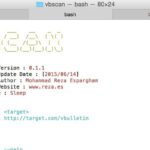OWASP VBScan short for vBulletin Vulnerability Scanner is an open-source project in Perl programming language to detect VBulletin CMS vulnerabilities and analyse them. Features VBScan currently has the following: Compatible with Windows, Linux & OSX Up to date exploit database Full path disclosure Firewall detect & bypass Version check Upgrade config finder Random user agent […]
perl
Moscrack – Cluster Cracking Tool For WPA Keys
Moscrack is a PERL application designed to facilitate cracking WPA keys in parallel on a group of computers. This is accomplished by use of either Mosix clustering software, SSH or RSH access to a number of nodes. With Moscrack’s new plugin framework, hash cracking has become possible. SHA256/512, DES, MD5 and *Blowfish Unix password hashes […]
Web-Sorrow v1.48 – Version Detection, CMS Identification, Enumeration & Server Scanning Tool
Web-Sorrow is a PERL based tool for misconfiguration, version detection, enumeration, and server information scanning. It’s entirely focused on enumeration and collecting information about a target server. Web-Sorrow is a “safe to run” program, meaning it is not designed to be an exploit or perform any harmful attacks. There’s a couple of other tools that […]
web-sorrow – Remote Web Security Scanner (Enumeration/Version Detection etc)
web-sorrow is a PERL based tool used for checking a Web server for misconfiguration, version detection, enumeration, and server information. It is NOT a vulnerability scanner, inspection proxy, DDoS tool or an exploitation framework. Current Functionality -S – stands for standard. a set of Standard tests and includes: indexing of directories testing, banner grabbing, language […]
DotDotPwn v1.0 – Directory Traversal Checker/Scanning Tool
A simple PERL tool which detects several Directory Traversal Vulnerabilities on HTTP/FTP Servers. This AttackDB version currently has 871 traversal payloads. This tool was tested against various Kolibri+ WebServer v2.0 and Gefest WebServer v1.0 (HTTP servers) giving good results identifying the right vulnerability strings. Those HTTP servers were vulnerable, and somebody reported those vulns on […]

